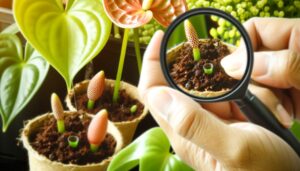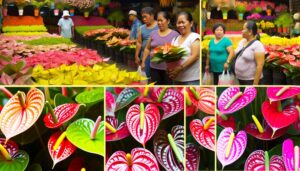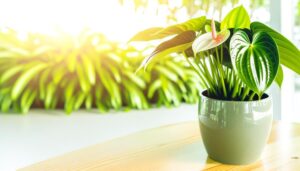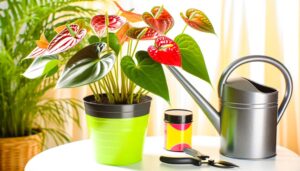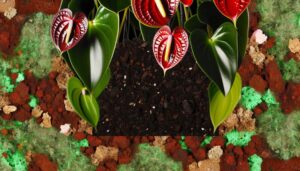5 Essential Tips for Anthurium Jungle Bush Care
Caring for your Anthurium Jungle Bush begins with watering when the top inch of soil is dry and using tepid, filtered water. Place it in bright, indirect light, ideally near an east or north-facing window.
Use a well-aerated, slightly acidic soil mix and repot every two years. Fertilize every 4-6 weeks with diluted, balanced fertilizer, observing for lush foliage.
Regularly inspect for pests, using insecticidal soap or neem oil as needed, and guarantee proper air circulation to prevent fungal problems. Mastering these details guarantees your Anthurium thrives and blooms beautifully; there’s more to it for a flourishing plant.
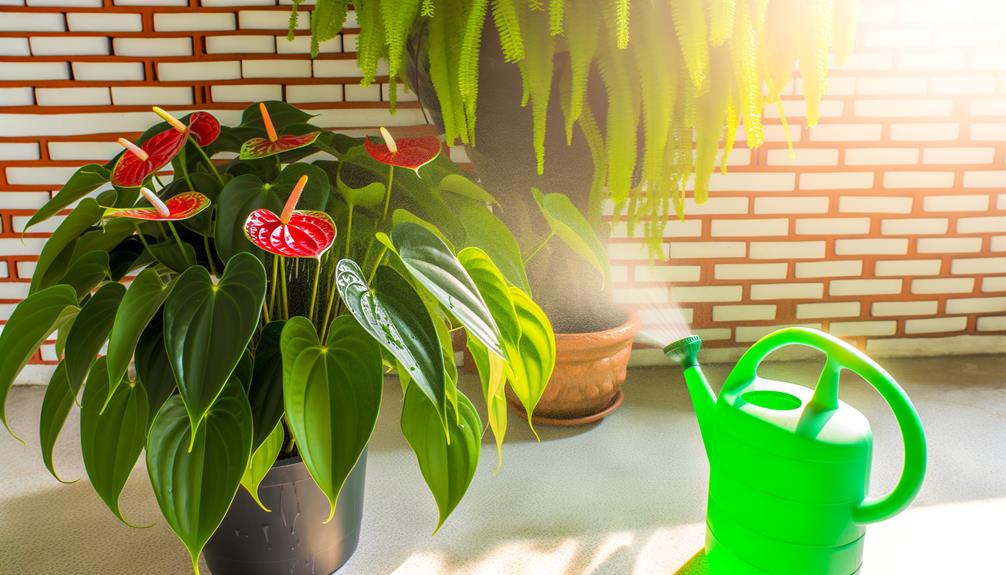
Key Takeaways
- Water when the top inch of soil is dry and use tepid, filtered water.
- Place in bright, indirect light near an east or north-facing window.
- Use well-aerated, slightly acidic soil and a pot with drainage openings.
- Fertilize every 4-6 weeks with diluted, balanced fertilizer.
- Regularly check for pests and diseases, and use insecticidal soap or neem oil as needed.
Proper Watering Techniques

Ensuring your Anthurium Jungle Bush thrives begins with mastering the precise watering techniques necessary for its best growth. Water your plant when the top inch of soil feels dry to the touch.
Use tepid, filtered water to avoid shocking the roots with temperature extremes or harmful chemicals. Water thoroughly until excess drips from the drainage holes, ensuring the entire root system gets hydrated. However, don’t let the plant sit in standing water, as this can lead to root rot.
Maintain consistent moisture but allow slight drying to mimic its natural, tropical habitat. Investing in a moisture meter can help you monitor soil hydration levels accurately.
Ideal Light Conditions
Your Anthurium Jungle Bush thrives best in bright, indirect light, which mimics the dappled sunlight of its native tropical understory environment.
Position it near an east or north-facing window where it can receive filtered light without direct sun exposure. Direct sunlight can scorch the leaves, causing brown spots and stress.
If natural light is insufficient, consider using fluorescent lights to guarantee your plant receives 10-12 hours of light daily.
Remember, too little light will hinder its growth and reduce flowering. Rotate the plant periodically to make sure even light distribution on all sides.
Soil and Potting Needs
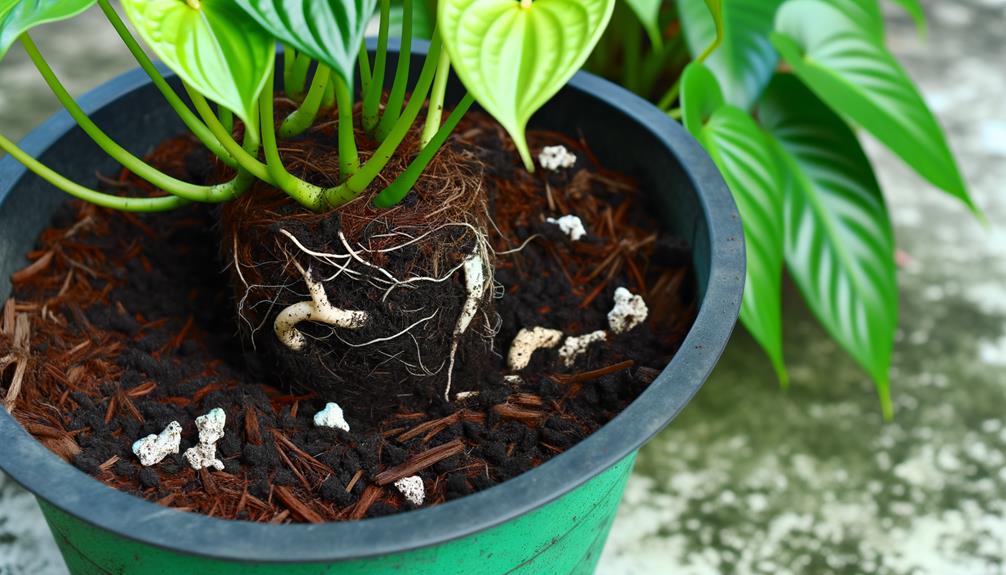
For optimal growth, plant the Anthurium Jungle Bush in a well-aerated soil mix that drains well and is rich in organic material. Use a blend of orchid bark, perlite, and peat moss to retain moisture while promoting airflow.
Maintain the soil’s pH at a slightly acidic level, within the range of 5.5 to 6.5. Choose a container with drainage openings to prevent waterlogging, which may lead to root decay.
Regularly repotting every two years is crucial to supply new nutrients and accommodate the plant’s expansion.
During repotting, gently remove excess soil from the roots and replace it with fresh mix. Handle the plant’s roots delicately to prevent harm.
This thorough attention guarantees the thriving of your Anthurium Jungle Bush, displaying its luxuriant foliage and vivid blossoms.
Fertilizing Requirements
To support vigorous growth, apply a balanced, water-soluble fertilizer to your Anthurium Jungle Bush every four to six weeks during the growing season. Choose a fertilizer with equal parts nitrogen, phosphorus, and potassium (such as a 20-20-20 formulation).
Dilute the fertilizer to half the recommended strength to avoid root burn and nutrient toxicity. Apply it evenly around the base of the plant, ensuring thorough soil saturation.
Monitor your plant’s response; lush, green foliage indicates effective nutrient uptake. However, if you notice yellowing leaves or stunted growth, reassess the fertilization regimen.
Consistent, precise fertilization promotes healthy, vibrant foliage and robust flowering, ensuring your Anthurium Jungle Bush thrives and remains a stunning centerpiece in any setting.
Managing Pests and Diseases

While consistent fertilization supports vigorous growth, it’s equally important to vigilantly monitor your Anthurium Jungle Bush for signs of pests and diseases that could compromise its health.
Inspect leaves and stems regularly for aphids, mealybugs, and spider mites. These pests can be controlled with insecticidal soap or neem oil.
Guarantee proper air circulation and avoid waterlogging to prevent fungal infections like root rot. If you notice yellowing leaves or stunted growth, remove affected areas immediately and treat with a fungicide.
Regularly clean your plant’s surroundings to deter pests. By staying observant and proactive, you’ll secure your Anthurium Jungle Bush remains vibrant and healthy, enabling you to better serve others with a thriving, beautiful plant.
Conclusion
In caring for your anthurium jungle bush, keep in mind that these plants can improve indoor air quality by removing up to 87% of toxins in just 24 hours.
By mastering proper watering, ensuring ideal light conditions, selecting the right soil and pot, fertilizing correctly, and managing pests and diseases, you’ll keep your anthurium thriving.
Remember, a healthy anthurium isn’t just beautiful; it’s a powerful, natural air purifier, enhancing both your space and well-being.

